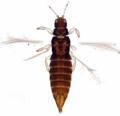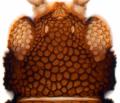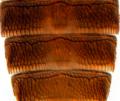Heliothrips haemorrhoidalis
Recognition data
Distinguishing features
Both sexes fully winged. Body dark brown but abdomen golden in freshly emerged adults; legs yellow; antennal segments III–V & VII–VIII yellow, VI variably brown; fore wing pale with hind margin and veinal fork shaded. Head strongly reticulate, cheeks constricted into basal neck. Antennae 8-segmented, segments III & IV with simple sensorium, VIII slender and at least 3 times as long as VII. Pronotum reticulate at anterior and posterior, with no long setae. Mesonotum reticulate at anterior. Metanotum with reticulate triangle, median setae small and arise on anterior half of sclerite. Tarsi 1-segmented. Fore wing with apex rounded bearing long cilia; costa with widely spaced long cilia, posteromarginal cilia not wavy; veinal setae scarcely larger than microtrichia. Abdominal tergites strongly reticulate on lateral thirds, II–VIII median setae long and close together; VIII with long postero-marginal comb of microtrichia; tergite X short with complete median division. Sternites with three pairs of small marginal setae.
Male very rare, except in Peru and Brazil (Mound, 1976).
Related and similar species
A second, and structurally similar, species of Heliothrips is known from southeastern Brazil (Mound & Monteiro, 1997), but the only other member of the genus is more distantly related and comes from South Africa.
Taxonomic data
Current valid name
Heliothrips haemorrhoidalis (Bouché)
Original name and synonyms
- Thrips haemorrhoidalis Bouché, 1833: 42
- Heliothrips adonidum Haliday, 1836: 443
- Heliothrips abdominalis Reuter, 1891: 165
- Heliothrips haemorrhoidalis var. ceylonicus Schmutz, 1913: 992
- Heliothrips haemorrhoidalis angustior Priesner, 1923: 89
- Heliothrips semirufus Girault, 1928: 1
- Dinurothrips rufiventris Girault, 1929: 1
Family placement
Thripidae, Panchaetothripinae
Common names
Greenhouse thrips
Biological data
Life history
Larvae and adults feeding on lower surface of leaves; pupae also on leaves.
Host plants
Feeding on the leaves of a very wide range of trees and shrubs, including some ferns, but rarely on herbaceous plants or on plants with soft leaves (Scott-Brown & Simmonds, 2006). Large populations are particularly common on plants that are water-stressed.
Tospoviruses vectored
None
Crop damage
Leaves become mottled due to feeding damage, with lower surface of leaves bearing characteristic black spots of larval fecal material.
Distribution data
Area of origin
South America, probably Peru (Mound, 1976).
Distribution
Widespread around the world in the tropics and subtropics, also in greenhouses in temperate regions.







